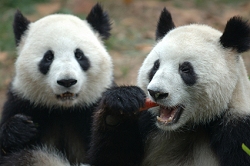THE WORLD WILDLIFE FOUNDATION
 The World Wildlife Foundation works on protecting the world’s wildlife and environment through various programs which are grounded in science.
The World Wildlife Foundation works on protecting the world’s wildlife and environment through various programs which are grounded in science.
The World Wildlife Fund (WWF) has been a conservation leader for 40 years and is the largest international conservation fund in the world. At WWF many scientists, naturalists, economists, educators,lobbyists, communicators and political leaders work together.
I interviewed Ethan Taylor, an educational director at WWF in Washington D.C. I was wondering was WWF was so popular and he explained. “Everyone loves our panda (logo). WWF is also popular because all living things from the smallest of invertebrates to the largest of mammals are part of the goal to be protected,” he explained.
There are many global threats that create danger to life on earth. WWF recognizes these threats and forms councils to study these threats. One of these threats is the timber trade, which destroys forest space for cropland. The second threat is that fisheries are ready to collapse.
Marine areas need to be protected and toxic contaminants better controlled.
Third, living things around the world are at risk from toxic chemicals. These chemicals affect wildlife and people.
Fourth, wildlife are suffering the consequences of severe climate change. Some of the other animals that WWF protects include the crocodile,cheetah, Asian elephant, sea turtle, chimpanzee, bald eagle and the leopard.
WWF focuses its conservation efforts at an eco-region where the highest number of species have the best chance to survive and where limited resources can be applied best. You can check out their site on the web and donate money or buy one of their WWF t-shirts or other products.
ENVIRO FACTS
* Recycling one glass jar saves enough energy to light a 100-watt bulb for four hours.
* Recycling one aluminum can results in 97 per cent less water pollution
* Manufacturing new paper products form waste paper uses at least one-third less energy than making new paper from wood pulp,saves trees, and results in 74 per cent less air pollution,
A SEEDLING GREENHOUSE
Greenhouses are places where plants can get extra sun, warmth and moisture. They are made of glass and see-through plastic. Make a minigreenhouse for young plants!
Ask a grown up to help you cut off the top flaps of a carton, and large windows on every side. Cover the top and side opening with clear plastic taped to the box.
Your greenhouse will let in sunlight and keep out chilly winds. Perfect for young seedlings! You can put pretty stickers or draw pictures on the carton. * Small children should ask for help with a dry cleaning bag.
A SIMPLE BIRDBATH
 One of the simplest birdbaths to make is to take an up-turned garbage can lid and fill it with a layer of pretty pebbles to give the birds firm footing. The pebbles will weight the lid. Birds like a place to perch after bathing, so place the lid near some brush or under a tree.
One of the simplest birdbaths to make is to take an up-turned garbage can lid and fill it with a layer of pretty pebbles to give the birds firm footing. The pebbles will weight the lid. Birds like a place to perch after bathing, so place the lid near some brush or under a tree.
Put it on the ground (In a open area where birds feel safe) or on a pedestal. A tree stump will do, or rig the lid by tying a rock to the handle and placing it on top of a length of a clay drainage pipe. Check the level of water occasionally, and watch the birds have a blast!
ROCK RUBBINGS
All you need is a sheet of lightweight paper and a wax crayon (dark colors show up best). Peel the paper covering off the crayon and hold it horizontally. A profile of the rockin your state, for instance, might include small specimens of various rocks, rock rubbings, photographs of local rocks used in architecture of sculptures and relevant statistics. Or create an art collage made from rock rubbings for an interesting piece of abstract art!
EAGLE SIGHTINGS
 In the 1960’s there were no eagles along the MIssissippi River. But, forty years later, hundreds of the birds now visit open water areas along the river.
In the 1960’s there were no eagles along the MIssissippi River. But, forty years later, hundreds of the birds now visit open water areas along the river.
You may want to learn about Eagles regally flying along the 261-mile length of the Upper Mississippi National Wildlife and Fish Refuge that hugs the shores of the Mississippi River. Read all about eagle sightings on the Web at www.nationaleaglecenter.org/index.htm The magnificent Eagles have a body length of 30 to 43 inches and a wing span of six to eight feet!
COLONIAL AMERICAN WEATHER LORE
Strong increased odors of swamps, ditches and cellars, warns of rain. A halo around the sun or moon means a lengthy slow rain, within eight hours. Heavy dew at night means a fair dry day tomorrow.
BUTTERFLY WORLD
If you visit Coconut Creek, Florida, stop in at Butterfly World. It’s a living museum, full of fluttering butterflies that land on your head and shoulders. It also has beautiful gardens filled with the plants that butterflies love

